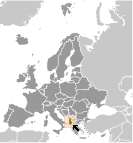World Atlas: Albania. On this page you can see the map, country flag and many detailed information about the people, history and economy of Albania.

Here you can find online selected information about the geography, inhabitants, government, economy and history of Albania. Included are selected statistics, an overview map and the detailed map of Albania. But let's start with the flag of Albania here:
Albania - Overview:
What you should know about Albania? Let's start with this: Albania declared its independence from the Ottoman Empire in 1912, but was conquered by Italy in 1939 and occupied by Germany in 1943. Communist partisans took over the country in 1944. Albania allied itself first with the USSR (until 1960), and then with China (to 1978). In the early 1990s, Albania ended 46 years of xenophobic communist rule and established a multiparty democracy. The transition has proven challenging as successive governments have tried to deal with high unemployment, widespread corruption, dilapidated infrastructure, powerful organized crime networks, and combative political opponents. Albania has made progress in its democratic development since first holding multiparty elections in 1991, but deficiencies remain. Most of Albania's post-communist elections were marred by claims of electoral fraud; however, international observers judged elections to be largely free and fair since the restoration of political stability following the collapse of pyramid schemes in 1997. Albania joined NATO in April 2009 and in June 2014 became a candidate for EU accession. Albania in November 2016 received a European Commission recommendation to open EU accession negotiations conditioned upon implementation of a judicial reform package passed earlier the same year. Although Albania's economy continues to grow, it has slowed, and the country is still one of the poorest in Europe. A large informal economy and a weak energy and transportation infrastructure remain obstacles.
Geography of Albania
 Where on the globe is Albania? The location of this country is Southeastern Europe, bordering the Adriatic Sea and Ionian Sea, between Greece to the south and Montenegro and Kosovo to the north. Total area of Albania is 28,748 sq km, of which 27,398 sq km is land. So this is not a large country. How could we describe the terrain of the country? This way: mostly mountains and hills; small plains along coast. The lowest point of Albania is Adriatic Sea 0 m, the highest point Maja e Korabit (Golem Korab) 2,764 m. And the climate is mild temperate; cool, cloudy, wet winters; hot, clear, dry summers; interior is cooler and wette.
Where on the globe is Albania? The location of this country is Southeastern Europe, bordering the Adriatic Sea and Ionian Sea, between Greece to the south and Montenegro and Kosovo to the north. Total area of Albania is 28,748 sq km, of which 27,398 sq km is land. So this is not a large country. How could we describe the terrain of the country? This way: mostly mountains and hills; small plains along coast. The lowest point of Albania is Adriatic Sea 0 m, the highest point Maja e Korabit (Golem Korab) 2,764 m. And the climate is mild temperate; cool, cloudy, wet winters; hot, clear, dry summers; interior is cooler and wette.
Inhabitants of Albania
Let's take a look how many people live in Albania. The number is: 3,047,987 (July 2017 est.). So this is not very populous country. Who lives here? Albanian 82.6%, Greek 0.9%, other 1% (including Vlach, Romani, Macedonian, Montenegrin, and Egyptian), unspecified 15.5% (2011 est.). What are the languages in Albania? Albanian 98.8% (official - derived from Tosk dialect), Greek 0.5%, other 0.6% (including Macedonian, Romani, Vlach, Turkish, Italian, and Serbo-Croatian), unspecified 0.1% (2011 est.). And the religions: Muslim 56.7%, Roman Catholic 10%, Orthodox 6.8%, atheist 2.5%, Bektashi (a Sufi order) 2.1%, other 5.7%, unspecified 16.2%. How old are the people in average? 32.9 years. We have to add that this number is the median - so one half of the people is older than this, one half is younger. And what is their life expectancy (at birth)? This: 78.5 years. Where the people live in Albania? Here: a fairly even distribution, with somewhat higher concentrations of people in the western and central parts of the country. The major urban areas of Albania are: Tirana (capital) 454,000 (2015).
Government and Economy of Albania
The capital of Albania is Tirana (Tirane) and the government type parliamentary republic. Let's take a look at the administrative divisions - 12 counties (qarqe, singular - qark); Berat, Diber, Durres, Elbasan, Fier, Gjirokaster, Korce, Kukes, Lezhe, Shkoder, Tirane, Vlore. Regarding the economy of Albania, important industrial products are food; footwear, apparel and clothing; lumber, oil, cement, chemicals, mining, basic metals, hydropowe. Important agricultural products are wheat, corn, potatoes, vegetables, fruits, olives and olive oil, grapes; meat, dairy products; sheep and goats. The most important export commodities are apparel and clothing, footwear; asphalt, metals and metallic ores, crude oil; cement and construction materials, vegetables, fruits, tobacco and the most important export partners are Italy 50.5%, Serbia 8.1%, Kosovo 7.5%, Greece 4.2% (2016). The most important import commodities are machinery and equipment, foodstuffs, textiles, chemicals and the most important import partners are Italy 29%, Germany 9.4%, China 8.7%, Greece 7.8%, Turkey 7.8%, Serbia 4.1% (2016). How rich is Albania and how rich are people in this country? The most important number here is GDP per capita (PPP): $12,500 (2017 est.). This is quite good. Let's add that this means Gross Domestic Product per person, which is recalculated with respect to the relative cost of local goods and services. And one more important number - population below poverty line: 14.3% (2012 est.).